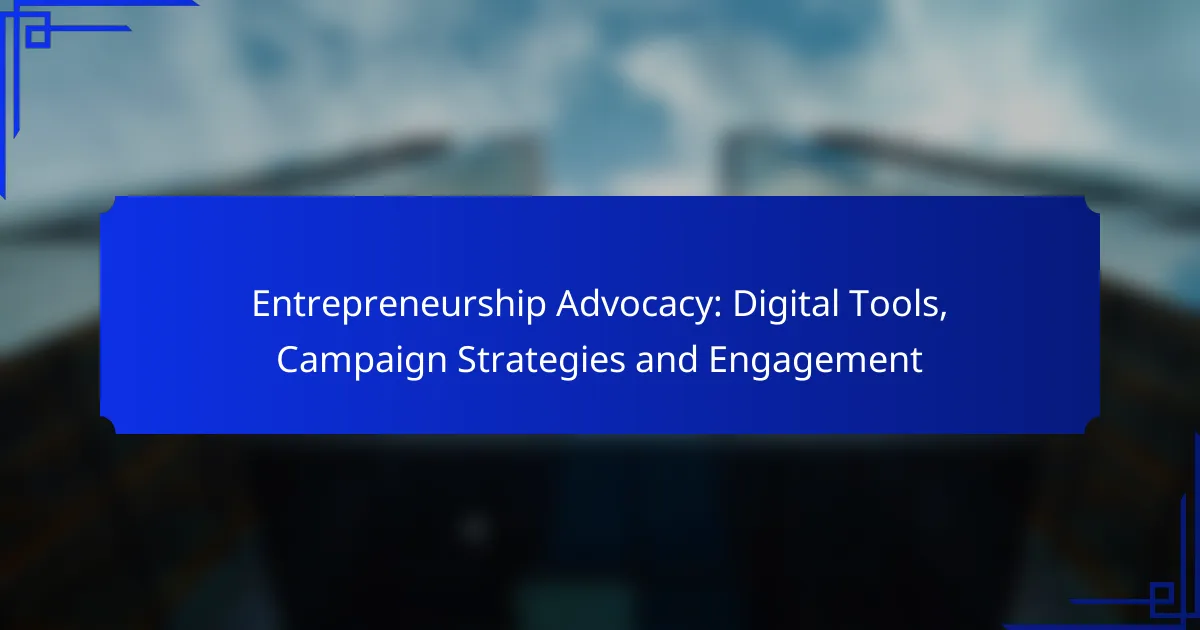Entrepreneurship advocacy is significantly enhanced by digital tools that improve communication and outreach, allowing for more effective campaign design and project management. By understanding the audience and setting clear goals, advocates can create impactful strategies that resonate and drive action. Engaging tactics such as webinars and social media collaborations further strengthen connections and awareness within the community.

What digital tools support entrepreneurship advocacy?
Digital tools play a crucial role in supporting entrepreneurship advocacy by enhancing communication, streamlining processes, and improving outreach efforts. These tools can help entrepreneurs effectively design campaigns, manage projects, and engage with their audience.
Canva for campaign design
Canva is a user-friendly graphic design platform that enables entrepreneurs to create visually appealing marketing materials. With a wide range of templates for social media posts, flyers, and presentations, users can easily customize designs to fit their brand identity.
To maximize Canva’s potential, focus on maintaining brand consistency through color schemes and fonts. Utilize the drag-and-drop features to quickly assemble professional-looking graphics without needing extensive design skills.
Mailchimp for email marketing
Mailchimp is a powerful email marketing tool that helps entrepreneurs manage their mailing lists and automate campaigns. It offers features like customizable templates, audience segmentation, and performance analytics, making it easier to reach the right people with tailored messages.
When using Mailchimp, consider segmenting your audience based on interests or behaviors to improve engagement rates. Regularly analyze campaign performance metrics to refine your strategies and optimize future emails.
Trello for project management
Trello is a visual project management tool that allows teams to organize tasks and collaborate effectively. Its board and card system helps users track progress, assign responsibilities, and set deadlines, making it ideal for managing advocacy projects.
To get the most out of Trello, create boards for different projects and use labels to categorize tasks. Regularly update the status of cards to keep everyone informed and ensure accountability within the team.
Slack for team communication
Slack is a messaging platform designed for team collaboration, enabling real-time communication through channels and direct messages. It integrates with various tools, making it easier to share files and updates without cluttering email inboxes.
To enhance communication on Slack, establish clear channels for different topics or projects. Encourage team members to use threads for specific discussions to keep conversations organized and focused.
Hootsuite for social media management
Hootsuite is a comprehensive social media management tool that allows entrepreneurs to schedule posts, track engagement, and analyze performance across multiple platforms. This helps streamline social media efforts and ensures consistent messaging.
When using Hootsuite, take advantage of its analytics features to identify which posts resonate most with your audience. Regularly review and adjust your content strategy based on these insights to improve overall engagement and reach.

How to create effective campaign strategies?
Creating effective campaign strategies involves understanding your audience, setting clear goals, and utilizing various techniques to engage stakeholders. A well-structured approach ensures that your message resonates and drives action.
Define target audience
Defining your target audience is crucial for tailoring your campaign strategies effectively. Identify demographics such as age, gender, location, and interests to create a clear profile of your ideal supporters.
Use surveys, social media analytics, and market research to gather insights about your audience’s preferences and behaviors. This information will help you craft messages that speak directly to their needs and motivations.
Set clear objectives
Setting clear objectives provides direction and measurable outcomes for your campaign. Objectives should be specific, measurable, achievable, relevant, and time-bound (SMART) to ensure clarity and focus.
For example, instead of a vague goal like “increase awareness,” aim for “increase social media engagement by 30% over the next three months.” This specificity allows for better tracking of progress and adjustments as needed.
Utilize storytelling techniques
Storytelling techniques can significantly enhance the emotional appeal of your campaign. Craft narratives that highlight personal experiences or testimonials related to your cause, making it relatable and engaging for your audience.
Consider using various formats, such as videos, blog posts, or social media stories, to share these narratives. A compelling story can inspire action and foster a deeper connection with your audience.
Incorporate data-driven insights
Incorporating data-driven insights into your campaign strategies helps to validate your approach and optimize performance. Analyze data from previous campaigns, audience engagement metrics, and market trends to inform your decisions.
Utilize tools like Google Analytics or social media insights to track engagement and conversion rates. This information allows you to refine your strategies continuously, ensuring they remain effective and relevant to your audience’s interests.

What engagement tactics enhance advocacy efforts?
Effective engagement tactics for advocacy efforts include hosting webinars, leveraging social media influencers, and implementing community feedback loops. These strategies help build awareness, foster connections, and ensure that advocacy initiatives resonate with the target audience.
Host webinars for knowledge sharing
Webinars serve as a powerful tool for knowledge sharing, allowing advocates to present information directly to their audience. They can cover various topics related to entrepreneurship, such as best practices, regulatory changes, or success stories from local entrepreneurs.
To maximize impact, ensure that webinars are interactive, allowing participants to ask questions and engage with the content. Consider scheduling them during times that accommodate your audience, such as evenings or weekends, to increase attendance.
Leverage social media influencers
Social media influencers can amplify advocacy messages by reaching wider audiences and lending credibility to initiatives. Collaborating with influencers who align with your mission can help you tap into their established follower base and create authentic connections.
When selecting influencers, focus on those with genuine engagement rather than just high follower counts. A few well-chosen influencers can be more effective than a large number of less relevant ones. Develop clear guidelines for collaboration to ensure messaging remains consistent and impactful.
Implement community feedback loops
Community feedback loops are essential for understanding the needs and concerns of your audience. By actively soliciting input through surveys, focus groups, or social media polls, advocates can tailor their strategies to better serve the community.
Establish regular intervals for gathering feedback and communicate how it influences advocacy efforts. This transparency fosters trust and encourages ongoing participation, making community members feel valued and heard in the advocacy process.

What are the prerequisites for successful advocacy campaigns?
Successful advocacy campaigns require a clear understanding of local regulations and a robust network of supporters. These elements ensure that campaigns are compliant, effective, and able to mobilize resources efficiently.
Understanding local regulations
Familiarizing yourself with local regulations is crucial for any advocacy campaign. This includes knowing the legal requirements for fundraising, campaigning, and lobbying in your area. Different regions may have specific laws that dictate how campaigns can operate, including registration processes and financial disclosures.
To navigate these regulations, consider consulting with legal experts or local advocacy organizations. They can provide insights into compliance and help you avoid potential pitfalls that could derail your efforts.
Building a strong network
A strong network is essential for amplifying your advocacy efforts. This involves connecting with individuals, organizations, and stakeholders who share your goals. Building relationships can lead to collaborative opportunities and increased visibility for your campaign.
Engage with your network through regular communication, events, and social media. Consider creating a coalition of like-minded groups to pool resources and strengthen your message. Remember, a diverse network can enhance your campaign’s reach and effectiveness.

How to measure the success of advocacy efforts?
Measuring the success of advocacy efforts involves evaluating various metrics that indicate engagement, conversion, and participant satisfaction. By systematically tracking these elements, organizations can refine their strategies and enhance their impact.
Track engagement metrics
Engagement metrics are crucial for understanding how well your advocacy efforts resonate with your audience. Key indicators include social media interactions, website traffic, and email open rates. For instance, a significant increase in social media shares can indicate a successful campaign message.
To effectively track these metrics, utilize tools like Google Analytics for website data and social media analytics platforms for engagement insights. Regularly reviewing these metrics will help identify trends and areas for improvement.
Analyze conversion rates
Conversion rates measure how effectively your advocacy efforts lead to desired actions, such as signing petitions or donating. A good conversion rate can vary widely, but aiming for a range of 2-5% is often considered effective in advocacy campaigns.
To analyze conversion rates, set clear goals for each campaign and use tracking links to monitor actions taken by users. This data can reveal which strategies are most effective and help optimize future campaigns.
Gather participant feedback
Participant feedback provides valuable insights into the effectiveness of your advocacy efforts. Surveys and interviews can help gauge public perception and satisfaction, offering qualitative data to complement quantitative metrics.
Consider implementing post-campaign surveys that ask specific questions about the participants’ experiences and suggestions for improvement. This feedback loop is essential for adapting your strategies and enhancing future advocacy initiatives.
